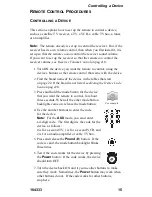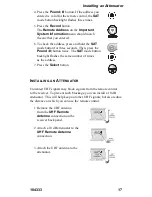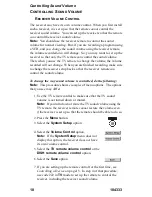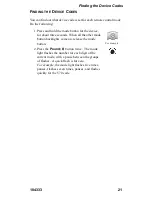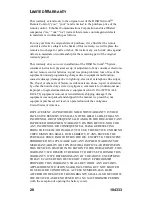
104333
27
When you
press a button
on the remote
control, the
device does
not do what
you expect.
You may be trying to
control a device other
than the receiver,
without pointing the
remote control
directly at the device.
The remote control
may be missing
batteries, the
batteries may be
incorrectly placed in
the remote, or the
batteries may be
weak or dead.
The remote may not
be set to the mode
that matches the
device you want to
control.
The remote may not
be set up to control
the device.
Remember that the remote control uses
IR signals to control devices other than
the receiver. IR signals travel only
40 feet or less, and cannot go through
walls or other solid objects. You must
point the remote control directly at the
device, with no objects blocking the line
of sight.
If the batteries are missing or dead, insert
fresh AAA-size batteries.
If the remote has fresh batteries, check
whether they are placed according to the
label diagram. If not, remove them and
place correctly.
Make sure to set the remote to the mode
that matches the device that you want to
control.
Make sure to set up the remote to control
all the devices that you want to operate.
The system
uses infrared
(IR) remote
control
extenders
(called
“pyramids”).
Electronic
devices exhibit
ultra-high
frequency
(UHF)
interference.
The extenders use
UHF signals to
transmit signals from
one room of the
building to another.
These signals may be
causing the
interference.
Temporarily stop using the extenders,
to see whether this eliminates the
interference. If the extenders are the
source of the interference, you will have
to avoid using them whenever you do not
want interference with other devices that
use UHF. This is because UHF signals
travel 100 feet or more, and go through
walls and other solid objects.
The system
uses infrared
(IR) remote
control
extenders
(called
“pyramids”).
The IR remote
control
extenders do
not seem to
work.
The IR sensor on the
extender that
receives the remote
control signals may
not be facing the
remote control.
The IR cable on the
extender that sends
the signal to the
receiver may not be
right in front of the
IR sensor on the
receiver front panel.
Make sure the extender that receives the
signal from the remote control is facing
the right way, so that the IR sensor can
receive the remote control signals.
Make sure the IR cable on the extender
that sends the signal to the receiver is
right in front of the IR sensor on the
receiver front panel, so that the receiver
IR sensor can receive the signals.
If doing the above does not solve the
problem, contact the manufacturer of the
extenders for help.
Содержание digital remote control
Страница 1: ...User Guide A single remote to control up to four devices...
Страница 33: ...104333 31 Notes...
Страница 34: ...32 104333 Notes...
Страница 36: ...FOR ALL YOUR CUSTOMER NEEDS CALL DISH NetworkTM CUSTOMER SERVICE at 1 800 333 DISH 3474 104333...



